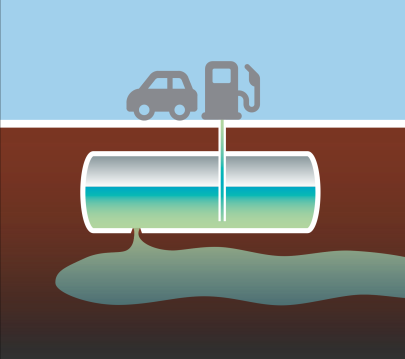
The MPCA's Petroleum Remediation Program addresses risks to people and the environment from contamination caused by leaking petroleum storage tanks. Petroleum has spilled or leaked into the environment at about 22,000 sites in Minnesota, often from underground storage tanks at gas stations, homes that use heating oil, and other businesses, where risks are not always readily apparent, and from aboveground storage tanks. Releases can create a risk to drinking water from groundwater or surface water contamination and can produce vapors that migrate to nearby homes and businesses.
Anybody who discovers or suspects a petroleum release of five gallons or more must report it immediately.
The owner or operator of the tank during or after the release — the responsible party per Minn. Stat. § 115C.021 — must investigate the contamination following MPCA guidelines with the help of an environmental consultant. Responsible parties pay for the investigation and cleanup. If there's no responsible party, or they can't afford the cleanup, the state may step in to handle the investigation and cleanup.
The Petroleum Tank Release Cleanup Fund (Petrofund), managed by the Minnesota Department of Commerce, reimburses eligible applicants up to 90% of reasonable and necessary costs for addressing a petroleum tank release. Petrofund’s guidelines outline which costs qualify for reimbursement, and the MPCA decides what actions are necessary to protect human health and the environment. Eligible applicants include both responsible parties and non-responsible parties who legally own or have a stake in the property where the release happened.
Additional resources
- Leaking and registered tank sites — Find locations of reported petroleum tank spills and releases in Minnesota.
- Petroleum Remediation Program maps — See petroleum sites in relation to wellhead protection areas, drinking water supply management areas, and source water assessments.
- Petroleum cleanup guidance — Find documents related to petroleum site investigation and remediation, reporting, and more.
- Consultant performance — For a current MPCA report summarizing various performance metrics for environmental consultants that do work for the Petroleum Remediation Program, please send an email request to petroleumreports.mpca@state.mn.us. This report includes data on field audits, report completions, and report rejections.
Gasoline additive project
The Petroleum Remediation Program is reevaluating nearly 5,000 sites that had releases from storage tanks for leaded gasoline where gasoline additive compounds may have contaminated groundwater.
The project focuses on the leaded gasoline additives ethylene dibromide and 1,2-dichloroethane, which were phased out in the late 1980s. Even though these compounds have not been used in gasoline for over 30 years, these compounds may persist in the environment and impact drinking water supplies for long periods of time.
Though the MPCA previously assessed and closed these sites using risk assessment information valid at that time, advancements in risk assessment, the ability to detect contamination at lower levels, and new drinking water standards from the Minnesota Department of Health have necessitated additional assessment at these sites.
Vapor lookback project
The goal of the petroleum vapor lookback project was to verify if MPCA guidance prevents the accumulation of harmful vapors in buildings near closed petroleum cleanup sites. New scientific information indicates that risk is higher when there is remaining petroleum contamination near buildings, as this can release harmful chemicals into the air. The project focused on a total of 750 sites closed prior to 2006, before the MPCA issued vapor intrusion guidelines.
If buildings were present within 150 feet of the cleanup site, a review of the closed leak site file determined if additional vapor investigation work was needed. This assessment included the collection of soil, groundwater, and soil vapor samples. Based on those results the sites either remained closed or were reopened.